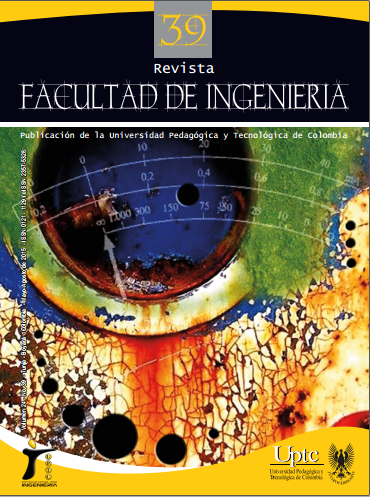Response of steel pulse galvanostatic of embedded steel in alkali actived slag concrete

Abstract
In this paper is presented the application of the galvanostatic pulse measurement which occurs in the activated slag concrete, submitted to accelerated carbonation processes. As reference material, we used ordinary Portland cement. Using the galvanostatic pulse technique enabled us the resistances values calculation which were involved separately in the carbonation process, allowing to find the corrosion rate by the Stern and Geary equation. The corrosion products were determined by the technique of Mössbauer Spectroscopy, corresponding to magnetite, goethite and wuestite.Keywords
corrosion, alkali actived slag, carbonation, Mössbauer spectrometry
References
- K. G. Papakonstantinou and M. Shinozuka, “Probabilistic model for steel corrosion in reinforced concrete structures of large dimensions considering crack effects”, Engineering Structures, 2013, vol. 57, pp. 306-326.
- J. Bastos de Souza and E. Pontes de Deus. “Damage mechanics applied for steel reinforcements in concrete structures under corrosion”, Procedia Materials Science, 2014, vol. 3, pp. 2000-2005.
- M. Gastaldi and L. Bertolini, “Effect of temperature on the corrosion behaviour of low-nickel duplex stainless steel bars in concrete”, Cement and Concrete Research, 2014, vol. 56, pp. 52-60.
- A. Michel, A.O.S. Solgaard, B.J. Pease, M.R. Geiker, H. Stang, J.F. Olesen, “Experimental investigation of the relation between damage at the concrete-steel interface and initiation of reinforcement corrosion in plain and fibre reinforced concrete”, Corrosion Science, 2013, vol. 77, pp. 308-321.
- Y. S. Choi, S. T. Yi, M. Y. Kim, W. Y. Jung and E. I. Yang. “Effect of corrosion method of the reinforcing bar on bond characteristics in reinforced concrete specimens”, Construction and Building Materials, 2014, vol. 54: 180-189.
- Y. Zhao, J. Yu and W. Jin, “Damage analysis and cracking model of reinforced concrete structures with rebar corrosion”, Corrosion Science, 2011, vol. 53, pp. 3388-3397.
- S. J. Han, D. H. Lee, K. S. Kim, S. Y. Seo, J. Moon and P. J. M. Monteiro, “Degradation of flexural strength in reinforced concrete members caused by steel corrosion”, Construction and Building Materials, 2014, vol 54, pp. 572-583.
- C. Cao, “3D simulation of localized steel corrosion in chloride contaminated reinforced concrete”, Construction and Building Materials, 2014, vol. 72, pp. 434-443.
- C. Andrade and J. Rodriguez, “Evaluation of steel durability in a construction system of reinforced mortar-polystyrene-mortar panels”, in Proceedings of the Fourth International Conference on Durability of Building Materials and Components, Singapore, 1987, pp. 623-630.
- S. Guzmán, J. C. Gálvez and J. M. Sancho, “Modelling of corrosion-induced cover cracking in reinforced concrete by an embedded cohesive crack finite element”, Engineering Fracture Mechanics, 2012, vol. 93, pp. 92-107.
- R. Francois and J. C. Maso, “Effect of damage in reinforced concrete on carbonation or chloride penetration”, Cement and Concrete Research, 1988, vol. 18, pp. 961-970.
- Y. Tong, V. Bouteiller, E. Marie-Victoire and S. Joiret, “Efficiency investigations of electrochemical realkalisation treatment applied to carbonated reinforced concrete — Part 1: Sacrificial anode process”, Cement and Concrete Research, 2011, 42: 84-94.
- I. Monteiro, F.A. Branco, J. de Brito and R. Neves. “Statistical analysis of the carbonation coefficient in open air concrete structures”, Construction and Building Materials, 2012, vol. 29, pp. 263-269.
- L. Fedrizzi, F. Azzolini and P. Luigi Bonora, “The use of migrating corrosion inhibitors to repair motorways concrete structures contaminated by chlorides”. Cement and Concrete Research, 2005, vol. 35, pp. 551-561.
- M. Cyr, “Influence of supplementary cementitious materials (SCMs) on concrete durability”, Woodhead Publishing Series in Civil and Structural Engineering, 2013, vol. 1, pp. 153-197.
- L. Pelà, A. Aprile and A. Benedetti, “Experimental study of retrofit solutions for damaged concrete bridge slabs”, Composites Part B, 2012, vol. 43, 2471-2479.
- M. Castellote, C. Andrade, X. Turrillas, J. Campo and G. J. Cuello, “Accelerated carbonation of cement pastes in situ monitored by neutron diffraction”, Cement and Concrete Research, 2008, vol. 38, pp. 1365-1373.
- M. Castellote and C. Andrade, “Modelling the carbonation of cementitious matrixes by means of the unreacted-core model, UR-CORE”, Cement and Concrete Research, 2008, vol. 38, pp. 1374-1384.
- J. Jeong, P. Sardini, H. Ramézani, M. Siitari-Kauppi and H. Steeb, “Modeling of the induced chemo-mechanical stress through porous cement mortar subjected to CO2: Enhanced micro-dilatation theory and 14C-PMMA method”, Computational Materials Science, 2013, vol. 69, pp. 466-480.
- M.A. Peter, A. Muntean, S.A. Meier and M. Böhm, “Competition of several carbonation reactions in concrete: A parametric study”, Cement and Concrete Research, 2008, vol. 38, 1385-1393.
- S.A. Meier, M.A. Peter, A. Muntean and M. Böhm, “Dynamics of the internal reaction layer arising during carbonation of concrete”, Chemical Engineering Science, 2007, vol. 62, pp. 1125-1137.
- W. Aperador, J.H Bautista-Ruiz and A.E Delgado, “Monitoreo de la corrosión de aceros embebidos en concretos obtenidos a partir de subproductos industriales”. Información Tecnológica, 2013, vol. 24(4), pp. 55-66.
- G. Roa-Rodríguez, W. Aperador and A. Delgado, “Resistance to Chlorides of the Alkali-Activated Slag Concrete” International Journal of Electrochemical Science, 2014, vol. 9, pp. 282 – 291.
Downloads
Download data is not yet available.